8 Proven Tips To Excel in Customer Service Voice in 2025
Mastering customer service voice is pivotal for forging positive interactions, resolving issues and cultivating loyalty, crucial for business prosperity.

Your customer service team struggles with phone interactions, leading to frustrated customers who hang up dissatisfied. Poor voice communication creates negative experiences that damage your brand reputation and customer loyalty.
Every mishandled call represents lost revenue and potential negative reviews. When customers feel unheard or misunderstood through poor voice service, they quickly switch to competitors who better meet their communication needs.
Master these eight proven voice techniques to transform your customer service calls into positive experiences. These strategies will help your team build stronger customer relationships and significantly improve satisfaction rates.
Customer service voice refers to the tone, manner and language used by customer service representatives when interacting with customers. It is a crucial aspect of providing excellent customer service and plays a significant role in shaping the overall customer experience.
A consistent and empathetic customer service voice helps build trust, ease customer frustration, as well as reinforce a brand’s identity. Whether it’s through live chat, phone calls, or emails, the way support teams communicate should reflect the company’s values while adapting to the customer’s mood and needs.
Key Objectives:
When things are said in the right time and right manner, 89% of customers will likely make another purchase because of the good experience they’ve had. Let’s explore about it more:
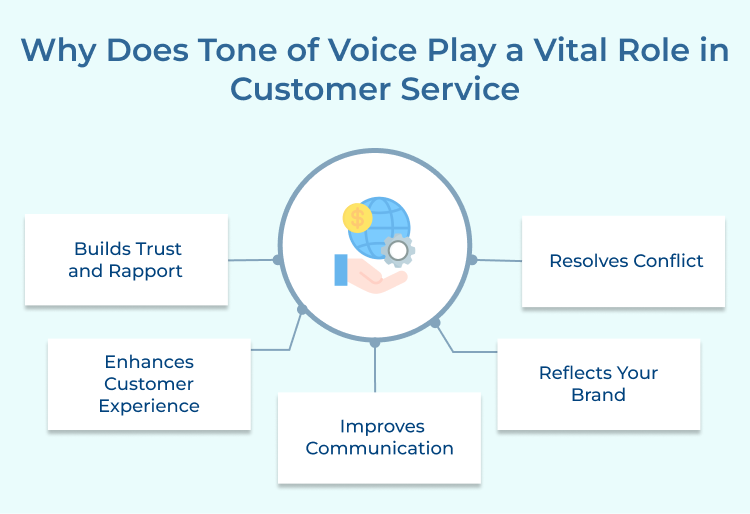
1. Builds trust and rapport: When you use an empathetic tone of voice, customers are more likely to feel that you understand their needs and are genuinely interested in helping them. It forges rapport, making customers more likely to return to your business in the future.
2. Resolves conflict: It is inevitable to encounter upset customers or the ones who are dissatisfied with their experience. Using a calm and reassuring tone of voice de-escalates conflicts while you get to work towards resolution that makes the customer happy.
3. Enhances customer experience: A positive tone enhances the overall customer experience, regardless of the outcome of the interaction. Customers will remember a pleasant interaction with a helpful customer service representative, even if their issue wasn’t fully resolved.
4. Reflects your brand: The tone of voice you use in customer service interactions should reflect the brand personality of your business. Whether your brand is professional/formal or casual/friendly, the tone of voice you use should be consistent with your brand image.
5. Improves communication: Clear communication is key in customer service and the tone you use can impact how well your message is received. Using a positive tone of voice ensures that customers understand the information you provide and feel confident in your ability to assist them.
Research states 78% of the customers would rather want their request declined in a professional tone . Let’s explore how to improve your customer service voice.
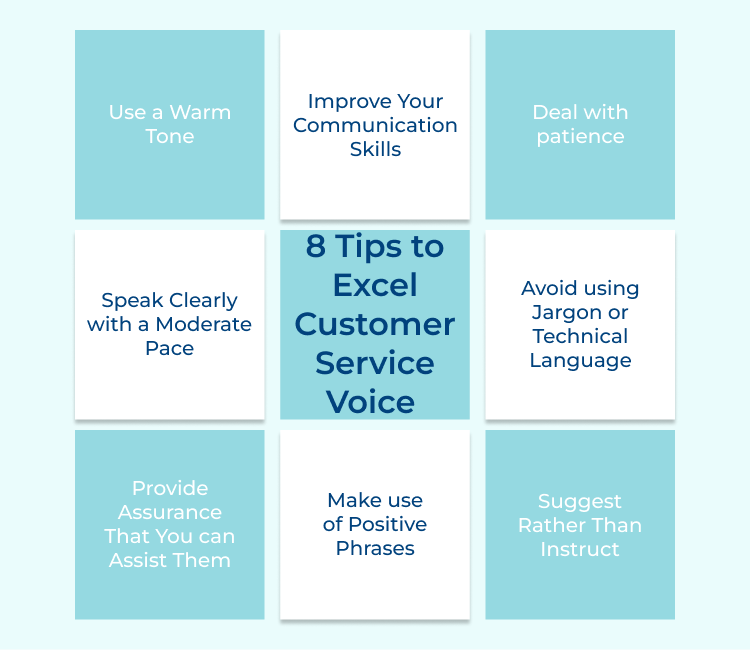
One of the first things customers notice when interacting with a customer service representative is their tone of voice. A warm and welcoming tone can make customers feel at ease as well as more receptive to assistance. Make sure to greet customers with a friendly tone, showing them that you are there to genuinely care about their needs.
Strong communication skills are essential for effective customer service. Practice active listening to fully understand the customer’s concerns and respond thoughtfully. Be attentive to their needs while providing clear information to address their questions.
Dealing with frustrated or upset customers can be challenging, but it’s important to stay patient and remain calm throughout the interaction. Avoid getting defensive or escalating the situation further. Take a deep breath, listen to their concerns and respond professionally.
Clear communication is key to ensuring that customers understand the information you provide. Speak clearly and at a moderate pace to prevent misunderstandings. Avoid speaking too quickly or mumbling, as this makes it difficult for customers to follow along.
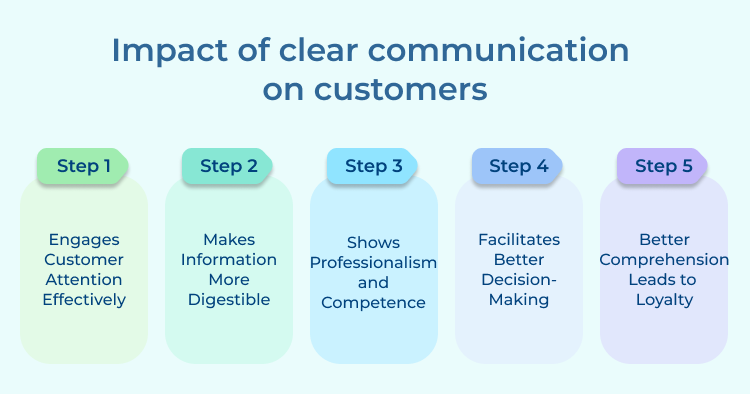
When assisting customers, it’s important to avoid using jargon or technical language that they may not understand. Keep your language simple and easy to comprehend, so customers can follow along without feeling overwhelmed or confused.
Customers often reach out to customer service for assistance with a problem. Assure that you are there to assist them and will do everything in your power to resolve their issue. Show empathy and understanding towards their concerns to gain their trust.
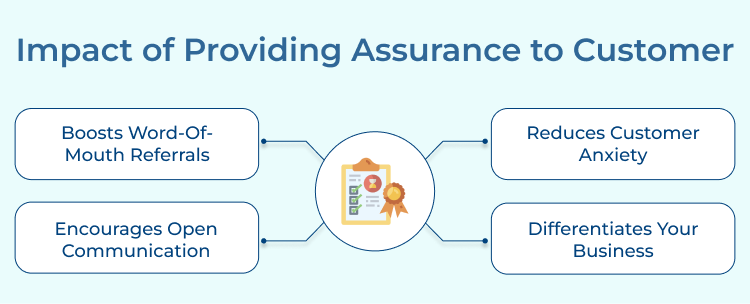
Using positive language creates a more pleasant interaction with customers. Instead of saying “I can’t do that,” try saying “Let me see what I can do to help you.” Providing solutions while also taking action to assist customers make a positive impact on their overall experience.
When providing guidance or assistance to customers, it’s important to suggest solutions rather than giving strict instructions. Offer options and recommendations based on their needs, allowing them to make an informed decision. The approach empowers customers and makes them feel more engaged in the resolution process.
Once you start showing empathy and understanding in your tone, expect 66% of the customers to stick to your brand out of loyalty. Here are four ways to develop a customer service voice.
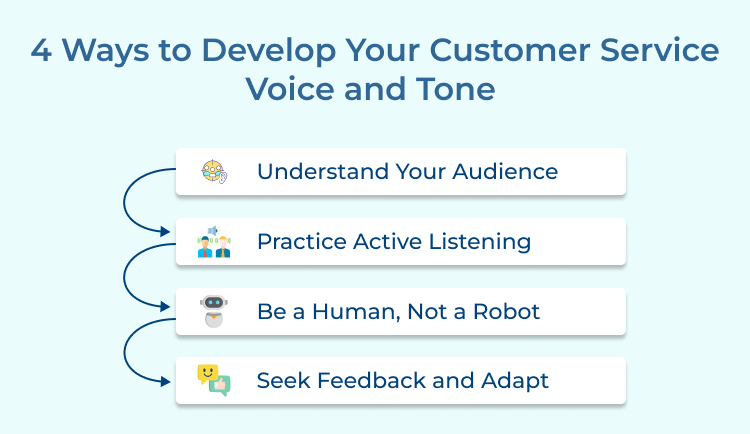
Before you develop a customer service voice and tone, it’s important to understand who your audience is. Are they young and tech-savvy, or older and more traditional? Knowing your audience will help you tailor your voice and tone that better resonates with them.
One of the key components of developing a customer service voice and tone is practicing active listening. Paying attention to customer’s needs, concerns and feedback will help you respond in a more empathetic manner. It will also help you adapt your voice and tone to meet the customer’s specific needs.
When communicating with customers, it’s important to be personable and empathetic. Avoid sounding robotic or scripted and instead, speak in a conversational tone. Customers appreciate knowing that they are speaking to a real person who cares about their concerns.
Lastly, seek feedback from customers as well as colleagues on your customer service voice and tone. Ask for constructive criticism and be open to making adjustments as needed. Continuously adapting your approach will help you improve and enhance your customer service skills over time.
There are several factors that influence customer service voice and being aware of these factors can help you improve the customer service interactions. Let’s get into them one at a time:
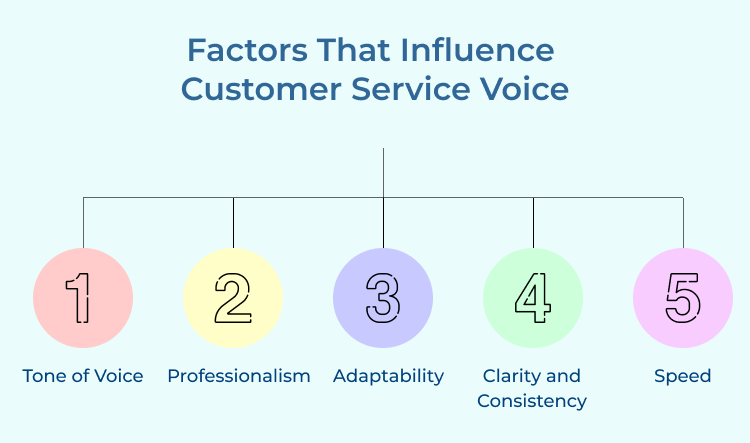
Different situations call for different tones and being able to adapt as well as read your customer’s needs is key. Let’s explore how to ensure positive outcomes:
When faced with an angry customer, it’s important to remain calm and empathetic. Use a soothing tone of voice and assure the customer that you understand their frustration. Apologize for any inconvenience they may have experienced and offer a solution to resolve the issue. For example, “I’m truly sorry for the inconvenience you’ve experienced. Let me see how I can help you sort this out.”
When interacting with a confused customer, you ought to use a patient and reassuring tone. Try to simplify the information and guide the customer through the process step by step. Avoid using technical jargon and speak clearly. For example, “I understand that this may be confusing for you. Let me explain it in simpler terms so you can better understand.”
When engaging with a happy customer, match their enthusiasm and positivity. Use an upbeat tone to show appreciation for their satisfaction. Acknowledge their positive feedback and thank them for their kind words. For example, “I’m thrilled to hear that you’re happy with our service! Thank you for your kind words, it means a lot to us.”
When encountering a rude customer, it’s important to maintain professionalism and avoid escalating the situation. Remain composed and maintain a neutral tone of voice. Focus on addressing the customer’s concerns and finding a resolution. For example, “I understand that you’re upset, and I’m here to help resolve the issue. Let’s work together to find a solution that meets your needs.”
Leveraging customer service voice is essential in providing exceptional customer experience (CX). By focusing on tone, empathy, active listening, as well as clear communication, companies enhance customer satisfaction, loyalty and brand reputation.
Consistent and personalized interactions with customers through various channels can create a positive relationship while also forging trust. By empowering customer service representatives to use their voice effectively, businesses can differentiate themselves from competitors and stand out in a crowded market. Ultimately, prioritizing the customer service voice contributes to a better overall CX and leads to long-term success for the organization.
Why is tone of voice important in customer service?
Tone of voice is important in customer service because it sets the tone for the entire interaction. A friendly and welcoming tone can make customers feel valued, while a rude or dismissive tone can lead to dissatisfaction. The way a company communicates with its customers can ultimately determine their loyalty and satisfaction levels.
Why is tone of voice a key factor in customer service?
Tone of voice is a key factor in customer service because it conveys the company’s values, personality and professionalism. Customers are more likely to engage with a company that speaks to them in a respectful and empathetic manner. A positive tone of voice can also help to build rapport with customers, leading to long-term relationships and repeat business.
How does the tone of voice affect customer service?
The tone of voice can greatly affect customer service by either enhancing or detracting from the overall experience. A warm and enthusiastic tone can make customers feel heard, while a cold or indifferent tone can leave them feeling ignored or unimportant. The way in which a company communicates with customers can influence their perception of the brand and their likelihood to recommend it to others.
How do I get a good customer service voice?
To develop a good customer service voice, it’s important to practice active listening, empathy and professionalism. Active listening involves paying attention to the customer’s needs and responding in a timely manner. Empathy entails understanding the customer’s perspective and showing genuine concern for their issues. Lastly, professionalism involves maintaining a positive and friendly tone while addressing customer inquiries or complaints. As you continue to practice, anyone can develop a strong customer service voice that resonates with customers as well as enhances their overall experience.